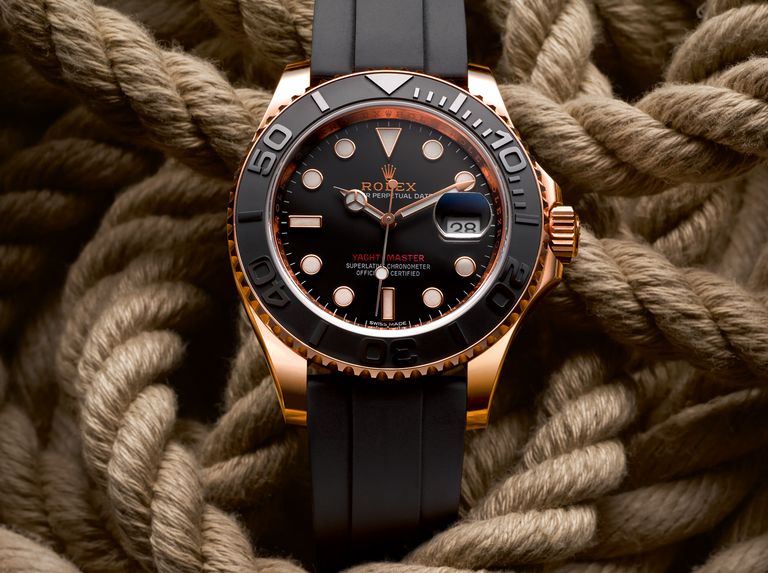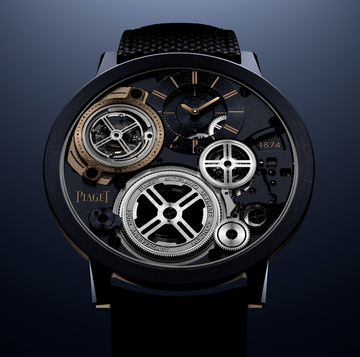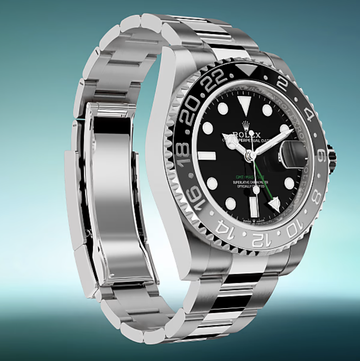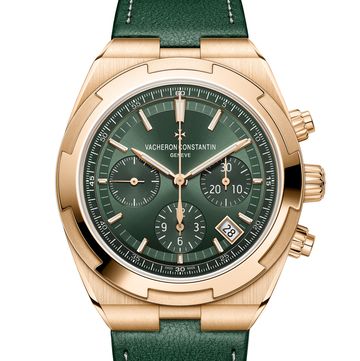To the readers of QP, Eric Clapton is as well known for his watch collecting as for his musical skills or his troubled personal life; yet it is difficult to realise that he only rose to prominence as a collector a dozen years ago. It was in June 2003 that Christie’s NYC held a sale which featured 25 watches from his collection which he sold to benefit the Crossroads foundation, a drugs rehabilitation charity which he had founded.
The most unusual piece was lot 181, a steel Cosmograph 6239 from 1965, with a most unusual dial, a strange combination of a “Paul Newman” dial and a conventional one. Whilst the running seconds and hour totaliser dials were like other Paul Newman dials, the 30 minute register lacked the square block indices at the five minute marks. At the very bottom of this register was a tricolour sector just outside the area between the 15 and 20 minute marks, a bizarre location for what was supposed to be a regatta timer; it would have made much more sense between the 0 and 5 minute marks.
This wasn’t the only unusual feature of the dial; the outer red seconds track was much further from the bezel than normal. But the strangest thing about the watch was that the expected name of “Daytona” was nowhere to be seen; in its place was the anachronistic model name of “Yacht Master”.
It was anachronistic because the watch dated from 1965 yet Rolex didn’t launch a watch with the Yacht-Master name until 1992 (the eagle-eyed among you will have noticed the arrival of a hyphen between the two words). In many ways the new Yacht-Master was a strange watch. Essentially a “dress” Submariner, available at first only in 18-karat gold, it was the first Rolex sports watch to be launched in gold.
The watch differed from the Submariner in several ways. Initially available with only a white dial, it looked much more “dressy” than the Submariner – even the gold version of the Sub. The bezel insert was now gold with raised polished numerals standing proud of the frosted background; it didn’t have a Fliplock bracelet with the diving suit extension, just a conventional Oysterlock one and, strangely as it used the same case as the Submariner, it was rated by Rolex as waterproof to 100m (the same as a Datejust), while the Sub could go three times as deep.
In many ways, the watch was a perfect example of Rolex during the Patrick Heiniger years: subdued ostentation. And it was during the Heiniger years that Rolex began to sponsor major yachting competitions, including the Maxi Yacht Rolex Cup (for seagoing leviathans which can cost between $5m and $100m to build) held in plutocrats playgrounds such as Newport, Rhode Island, Nice, Monaco and Porto Cuervo, further identifying the brand with money & privilege.
Then, two years later, Rolex did something with the watch which Tudor had been doing for many years; they made smaller version of it, in both 34mm (mid size) and 29mm (ladies size); like the 40mm original version, on both these new watches the bezel rotated both ways, unlike the Submariner’s one way safety system. The mid size was available with different length Oyster bracelets to enable it to be worn by either men or women. Strange as it may seem, these were the first Rolex sports models to be available in alternate sizes.
It took another four years before Rolex made any other changes to the watch, but 1999’s Baselworld saw the introduction of the most radical version thus far; the more affordable 40mm “Rolesium” version. This was, essentially, an all steel version of the Yacht-Master, other than the bezel insert which was now platinum, as was the frosted silver dial. The other major change was to introduce oversized luminous indexes & hands, allowing greater legibility in the dark. For the first time in its seven-year existence, the Yacht-Master was desirable and no longer thought of as the answer to the question that no-one had asked.
But Rolex was not content to sit on its laurels – there was another Yacht-Master to come, and 2007’s Baselworld crowd were shocked when they saw it. It looked like a Daytona, but didn’t have sub-registers at the 3 and 9 positions, or screw-down pushers (unlike any Rolex chronograph in the last 40 years) and what was the point of the backwards bezel, where the numbers went anti-clockwise?
It was and is, in fact, a regatta chronograph with a programmable countdown timer. It was based on the in-house Rolex Daytona movement (4130) but with an additional 70 components to enable it perform its new functions, making it by far the most complicated movement Rolex had ever made.
The radical part of the watch design was to utilise the rotating bezel to alter the functions of the winding/setting crown. With the bezel in its usual position, the crown & pushers operate as on any other Daytona, but turn the bezel through 90 degrees and the watch then enters its “programming” mode, for setting the countdown timer. The really clever feature is that once a particular countdown period has been set, the watch “remembers” it – the next time you need a countdown you will get the pre-set one, unless you reprogram the watch.
I have to be honest here and say that none of the Yacht-Master versions appealed to me; they seemed to be trying too hard and I don’t own a yacht or even aspire to. But then, this year at Baselworld, Rolex brought out a new Yacht-Master which had Rolex aficionados practically drooling. It incorporated all the recent advances in Rolex technology – the larger case used on all the other sports models, the anti-magnetic Parachrom hairspring and the ceramic bezel insert.
In the case of the new watch, however, the bezel insert is unlike any other sports model; in those watches the bezel numerals are engraved into the surface of the ceramic insert and then the base of the cavities is PVD’d in either gold or platinum. Here the numerals are raised (just like the current Yacht-Masters) from the matt base and the surface of the numerals is then given a high gloss polish. The finished look is just gorgeous.
Moreover, for the first time a Yacht-Master has a black dial, in high gloss lacquer giving a high contrast to the oversized indexes, which use the patented Rolex “Chromalight” luminous material. The indexes themselves are contained within a thin band of rose gold; because (for the first time in a Rolex sports watch) it is only currently available in Everose gold, a special formulation created in the firm’s own foundry. The dial is set off by the single line of red, proudly stating the model’s name.
All of the above is great, but what really sets the watch apart from any other Rolex is the strap; while rubber, silicon and other compounds have become fashionable lately: as always, Rolex chose to plough its own solitary furrow. The Oysterflex band has a flexible thin metal blade made from a titanium/nickel alloy at its core; so its heart (like all Rolex sports watches) is a metal bracelet; but the blade is encased in high density elastomer whose matt black surface matches perfectly with the bezel.
Recognising that not everyone has Stallone-like wrists, the watch has been introduced in both 40mm and 37mm sizes and. However, like the earlier versions, the new one is still water-resistant to only 100m. But in a triumphant year for Rolex when they replaced the less-than-attractive Day-Date II with the much more subtle 40mm version, brought out two new movements & deposed the Air King with a new range of Oyster Perpetuals, it was the new Yacht-Master which gained the most attention.
Speaking to dealers, collectors and Rolex fans worldwide, I know the watch has been greeted with almost unanimous acclaim and the orders have been pouring in; I await mine with barely disguised impatience.















